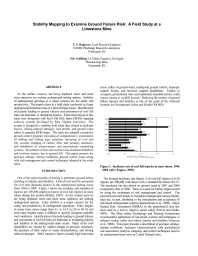Mining Publication: Stability Mapping to Examine Ground Failure Risk: A Field Study at a Limestone Mine
Original creation date: July 2009
As the surface reserves are being depleted, more and more stone operators are seeking underground mining options. Stability of underground openings is a major concern for the safety and productivity. This paper relates to a field study conducted at a large underground limestone mine in Central Pennsylvania. Identification of hazards leading to ground failures and assessment of roof fall risks are important in mitigating injuries. Field observations at this mine were integrated with Roof Fall Risk Index (RFRI) mapping software recently developed by West Virginia University. The system is designed to combine field study data related to geologic factors, mining-induced damages, roof profile, and ground water influx to generate RFRI maps. The mine has adopted a proactive ground control program consisting of comprehensive examination of drilling and bolting logs; precision surveying of roof and rib; accurate mapping of cutters, falls, and geologic structures; and installation of extensometers and microseismic monitoring systems. Investment of time and resources has eliminated fatalities and lost-time injuries due to ground fall. This paper presents the geologic settings, mining conditions, ground control issues along with risk management and control techniques adopted at the study mine.
Authors: TS Bajpayee, SR Schilling
Conference Paper - July 2009
NIOSHTIC2 Number: 20035813
Proceedings of the 28th International Conference on Ground Control in Mining, July 28-30, 2009, Morgantown, West Virginia. Peng SS, Barczak T, Mark C, Tadolini S, Finfinger G, Heasley K, Luo Y, eds., Morgantown, WV: West Virginia University, 2009; :135-142
See Also
- Diagnosing and Controlling Moisture-Sensitive Roof in Coal Mines
- Dynamic Failure in Deep Coal: Recent Trends and a Path Forward
- Geologic Characterization
- The Long-term Performance of Surface Support Liners for Ground Control in an Underground Limestone Mine
- Optimizing Secondary Roof Support with the NIOSH Support Technology Optimization Program (STOP)
- Practical Risk Assessment Guidelines for Identifying, Assessing, and Mitigating Stored Energy Hazards in Underground Coal Mines During and After a Mine Emergency
- Rock Falls
- Roof and Rib Hazard Assessment for Underground Stone Mines
- SPONCOM - A Computer Program for the Prediction of the Spontaneous Combustion Potential of an Underground Coal Mine
- SponCom - Spontaneous Combustion Assessment Software - 2.0
- Technology News 520 - A Method to Characterize Risk Associated With Mine Roof Conditions
- Technology News 545 - NIOSH Updates Spontaneous Combustion Assessment Software
- Page last reviewed: 9/21/2012
- Page last updated: 9/21/2012
- Content source: National Institute for Occupational Safety and Health, Mining Program


 ShareCompartir
ShareCompartir
